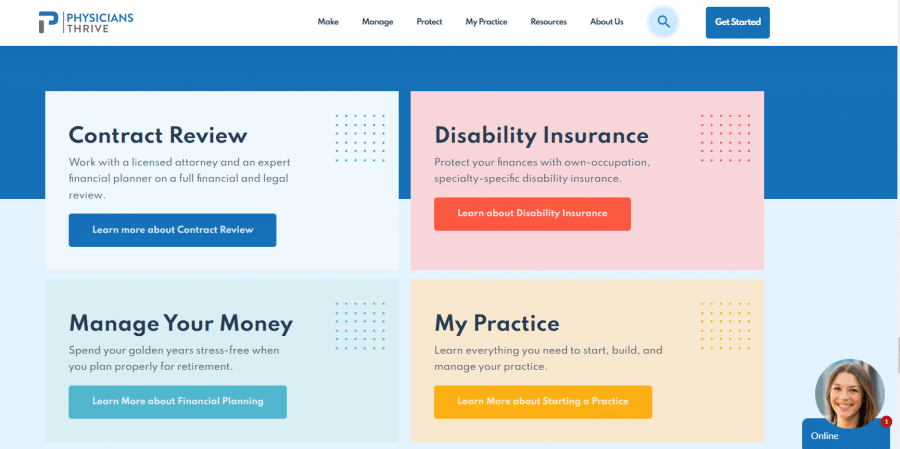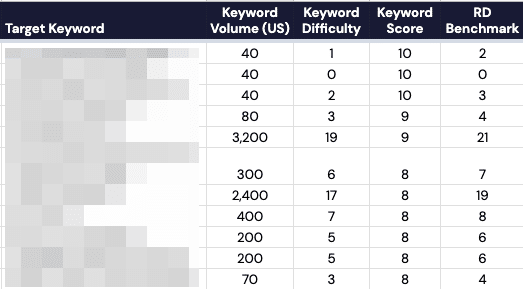Website traffic is one of the metrics we use to measure the success of content marketing campaigns. High traffic tells us that people are visiting the website and are interested in our content.
And if you’re attracting the right type of traffic to your site (people who are interested in your business and/or products), it means you’ll generate more leads and drive more sales.
In this case study, we’re going to look at one of our clients, Physicians Thrive.
We helped them grow their organic traffic by 2,758.1% (34,441 sessions!) in less than three years!
When We Started
We started working with Physicians Thrive in May of 2019. That month, their site saw 4,497 total sessions and 1,275 organic sessions* with 10 organic leads.
They came to us because they wanted to bring these numbers up. They wanted more traffic, and, more specifically, they wanted three times more leads than they were getting at the time.
*Organic sessions” refers to site visitors who arrived through a search engine. For instance, if a person Googled “insurance for physicians” and clicked one of PT’s articles on the search page, that would be considered organic traffic. “Total sessions” refers to all traffic: people who typed “www.physiciansthrive.com” into the search bar, previous visitors who already had the site saved in their browser history, etc.)
Our Strategy
With most clients, we focus 80% of our efforts on Google’s three most important ranking factors: content, RankBrain, and links.
- Content: we write the best resources on the internet about the topics that will be most valuable for you to rank for.
- RankBrain: we ensure that the content we write matches the intent of a user’s search. Put another way, we make sure that we’re creating a page that gives your customers everything that they’re hoping to find.
- Links: we get other websites to link to the most valuable pages on a your site.
With each client, we start with a four-step framework to understand the implementation plan that will drive most business growth. We:
- Analyze the competitive landscape
- Identify long-term ranking goals
- Build a content calendar
- Strengthen the site’s foundation
Let’s walk through each of those steps to discuss what we mean:
Analyzing the Competitive Landscape
Before launching any content strategy, it’s crucial to look at your competitors’ strategies.
In our competitive analysis process, we look at a few key factors:
Content Rankings
Which pieces of content on our competitors’ sites drive the most traffic?
Which get a lot of backlinks?
Which keywords do those articles rank for?
This gives us an idea of topics we may want to cover in our own content. If we think our team can create a better piece of content or offer a unique take on that topic, we might want to target some of the same keywords.
We also look for low-competition keywords. When there isn’t as much competition for a particular keyword, there’s a better chance we’ll land at the top of Google and get the lion’s share of traffic from those searches.
Site Authority
How many domains link to the site?
What is the site’s Domain Rating on Ahrefs?
If a competitors’ site gets significantly more traffic and backlinks than your site, we probably won’t be able to rank for all of the same keywords as them. Google uses backlinks as an indicator of authority (if a lot of sites link to you, you must know what you’re talking about), so they tend to reward the most linked-to sites.
In the case of Physicians Thrive, we identified three companies offering similar services to PT who all had high-performing websites:
- Competitor #1’s website had backlinks from 2,700 external domains
- Competitor #2’s website had backlinks from 2,100 external domains
- Competitor #3’s website had backlinks from 937 external domains
At the time, Physicians Thrive only had backlinks from 68 external domains.
In other words, we knew that we weren’t going to be able to beat them for certain keywords until we started earning backlinks and building site authority.
Identifying Long-Term Ranking Goals
Once we have an idea of how your site compares to your competitors’ sites, we start to get a realistic picture of how our services will help you.
We have to ask ourselves several questions:
- How much traffic can we expect to drive from the keywords we’re certain we can rank for?
- How long will it take to rank for some of the more competitive, high-traffic keywords?
- How long will it take us to build a competitive backlink profile?
- What can we do to expedite this process?
From there, we can start to set goals for our campaign:
We want to earn x amount of backlinks per month, and we want this article to rank for these keywords by this date.
Building a Content Calendar
A content calendar is a finalized list of the articles we plan to write.
For our Physicians Thrive content strategy, the articles on our calendar fell into two categories:
On-site Blogs
These articles are published on your site and are intended to drive traffic to that site. We run them through a rigorous SEO process to ensure they appear in search results and compete for the top spots.
Content Revamps
These are articles you already published on your site that don’t performing as well as they could. Physicians Thrive had a number of blogs on their site that we knew could perform better with a bit of revamping.
Strengthening the Site’s Foundation
Before we put our content plan into action, we ensure that your site is optimized for search engines. If it’s not, our content marketing efforts be limited in how much we can help you grow.
Here are two of the primary things we do to prepare a site for our content strategy:
Defining the Site’s Positioning
Just as we choose a target keyword for each article, we choose target keywords for the primary pages on your website.
Even if we don’t expect to rank for these keywords in the immediate future, incorporating them into each page’s meta title tells search engines what the site is about. That way, each page is at least indexed for our target keywords (even if it shows up on page 22 for the first few months).
Auditing for Technical SEO
Technical SEO is a broad term for all of the SEO tasks that happen on a website’s back-end.
We run a comprehensive technical audit on all of our clients’ sites. Depending on the results of the audit, we’ll make a number of adjustments:
- Optimizing the XML sitemap to tell search engines which pages should be indexed and which should be hidden from search results
- Installing file-compression plugins for site speed optimization
- Redesigning the site for mobile-responsiveness
- Deleting or de-indexing duplicate content
- Incorporating relevant schema markup to make it easier for search engines to understand the contents of the site
- Implementing a Secure Sockets Layer (SSL) for site security
There are a lot more tasks involved in technical SEO — those are just some of the most common ones.
Related: Should You Hire a Digital Marketing Agency?
Implementation Steps
Here are a few of the ways we implemented our content strategy for Physicians Thrive:
Revamped High-Potential Articles
When they came to us for the site redesign, they already had some blogs on their site that were driving significant amounts of traffic.
50% of their website traffic came through their blog!
So, in addition to publishing new blogs on their site, we revamped their existing articles to get them to drive more traffic.
This involved a few tasks:
- Identifying the articles driving the most conversions and reformatting all other articles to mimic those ones
- Looking for articles with some keyword rankings but not much traffic, then editing and adding to them to get them ranking better
- Adding CTAs to pages that didn’t already have them to help the pages generate leads
Targeted Low-Competition Keywords for Short-Term Brand Awareness
As we found in our competitive research, Physicians Thrive was up against some heavy competition — the lowest-performing of their primary competitors had 869 more backlinks than the PT site.
So, until we built up a strong backlink profile, we couldn’t expect to rank for the same keywords as them.
But, we could target some of the less-competitive keywords we found in their keyword rankings.
For instance, an article might rank for a keyword that’s only searched 100 times a month. For a competitor who gets 100,000 site visits a month, it wouldn’t make sense to spend time targeting that keyword. But, an article about a related keyword could end up ranking for that lower-volume keyword just because nobody else took the time to target that keyword.
In a case like Physicians Thrive, where competition is high and our site authority is relatively low, those low-volume keywords can be valuable. If 30% of the 100 searchers end up on the PT website every month, we’ve now put their business in front of 30 different potential customers.
And if we publish articles targeting four or more of those lower-volume keywords every month for a year, we can really start to build the site’s authority.
…While Targeting More Competitive Keywords for Long-Term Authority
Of course, the goal of any content marketing campaign is to eventually rank for some of the same keywords as our competitors. So while we’re building up brand awareness by targeting lower-volume keywords, we also want to plant the seeds for more significant rankings.
Working with the Physicians Thrive team, we identified some high-volume keywords that we wanted to rank for eventually, knowing that we could work our way toward the top of the SERPs as our other articles got more attention.
Read more about our keyword research process on our blog.
As part of this analysis process, we use the Root Domain Benchmark tool that we built to help us understand the feasibility of ranking for a given keyword.
We pull in data from Ahrefs to help us understand how many links we should expect to need to build to a given page to get it to rank in the top 10 results of Google for a particular keyword.
For example, to rank for the sample keyword above with 3,200 searches/month, we should target 21 links from different websites for a page related to that keyword theme.
In-depth content that matches search intent, paired with enough backlinks, is a proven recipe for success.
Building Backlinks to Expedite Ranking Growth
Our link building process focuses on relationship building.
We build relationships with publishers sites every day that are on the hunt for great resources that they can link to in order to provide a better experience for their readers.
Each month, we identify the most valuable pages on your site to build links to and convince a set number of these publishers to link back to those pages.
Reorganized Blog Structure
In our technical analysis of the site, we found that PhysiciansThrive.com had a relatively disorganized blog section. While human readers could easily navigate the blog, search engines might have a tough time crawling it (or indexing it page by page).
To help the spiders navigate the blog, we created a set of silo URLs to categorize each blog page. These silo URLs are based on the services that Physicians Thrive offers (retirement planning, contract review, disability insurance advising, etc.).
Now, instead of looking disorganized like this:
- physiciansthrive.com/mortgage-loans/
- /backdoor-roth-ira/
- /adp-401k-review/
- /restrictive-covenants/
- /physician-contract-lawyer/
- /physician-contract-termination/
… the URL of the site’s blogs are organized with sub-URLs, like this:
- /financial-planning/mortgage-loans/
- /financial-planning/backdoor-roth-ira/
- /financial-planning/adp-401k-review/
- /contract-review/restrictive-covenants/
- /contract-review/physician-contract-lawyer/
- /contract-review/physician-contract-termination/
A silo structure helps search engines understand the overarching topic of each article and how the blog articles relate to each other. This ensures that all blogs are indexed in the right searches.
Struggling to convince your boss to invest in content marketing? We’re here to help.
Let’s Look at How Their Traffic Improved Over the First Year
To recap:
We started with Physicians Thrive in May 2019 on our Standard Growth Content Marketing Service.
During the previous month, their website saw 4,497 sessions, with 1,275 of those sessions coming from organic search.
Organic traffic generated 10 leads that month.
Now, here’s how we helped them:
During the month of May 2020 — one year after we started working with them — their traffic looked like this:
- Total sessions: 5,137 (up 14.2% from May 2019)
- Organic sessions: 2,391 (up 87.5%)
- Total organic session leads: 21 (up 110%)
Here’s How Traffic Improved Over the Second Year
After the first year, Physicians Thrive was pleased with our results, so they signed on for a second year on our Enterprise Growth Content Marketing Service. We stuck to our strategy, made some adjustments, and drove even more traffic and leads to their site.
Here are the metrics for May 2021, two years after we began working with Physicians Thrive:
- Total sessions: 19,327 (up 329.8% from May 2019)
- Organic sessions: 16,015 (up 1,156.1%)
- Total organic session leads: 28 (up 180%)
Here’s How Traffic Has Improved Since Then
We continue to work with Physicians Thrive to this day. Our sister company, Interweb, redesigned their website from the ground up, which was a huge help for our content marketing efforts. You can read about the redesign here.
Now, in January of 2022, the metrics look like this:
- Total sessions: 43,125 (up 859% from May 2019)
- Organic traffic: 36,441 (up 2,758.1%)
- Organic leads: 89 (up 790%)
All in all, that’s a 790% increase in leads, an 859% increase in total sessions, and a 2,758.1% increase in organic sessions.
Conclusion
Content marketing has helped turn Physicians Thrive into an industry leader in less than three years.
Are you ready to take your business to the next level? Let’s see if Intergrowth is the right partner to help you grow.
Have burning questions about what it looks like to work with us? Read the short answers to the most common questions clients ask before working with us here.
SCALE YOUR ORGANIC TRAFFIC
Subscribe to our monthly newsletter







